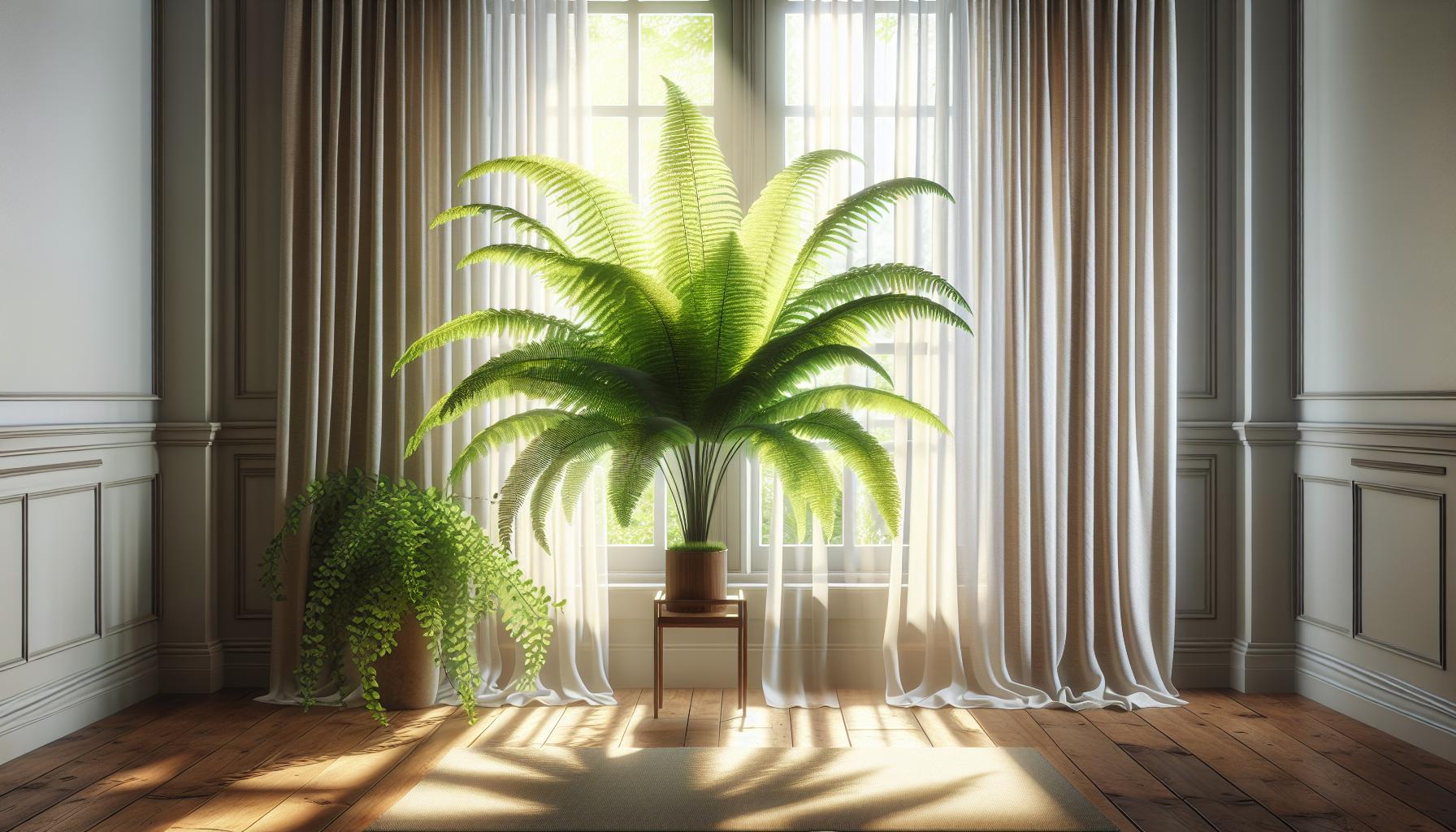
Wondering if your ferns need sun to thrive? You’re not alone. Many gardeners find themselves questioning the lighting needs of these lush, shade-loving plants. Ferns have a reputation for growing in dim, forested areas, but does that mean they can handle the dark corners of your home?
The truth is, while ferns don’t require direct sunlight, they do need a certain amount of light to photosynthesise effectively. It’s all about finding that sweet spot where your ferns can flourish without getting scorched by the sun’s rays. Let’s delve into what makes the perfect lighting conditions for your ferns to ensure they remain vibrant and healthy.
The Lighting Needs of Ferns
When nurturing ferns in your home or garden, understanding their lighting requirements is critical for their growth and health. Unlike many plants that bask in the sun, ferns thrive in indirect sunlight.
Your ferns’ natural habitat would typically be on forest floors or in dense canopies where direct sunlight is filtered through layers of leaves. This environment provides a dappled light condition, which is what you’ll aim to replicate. Ferns exposed to too much direct sunlight can experience scorching on their fronds, leading to a loss in vibrancy and potential decay.
Indoor growers will find it beneficial to place ferns near a north-facing window where they receive gentle, ambient light. If southern exposure is your only option, make sure you use sheer curtains or blinds to diffuse the intensity of the sunlight. Outdoor ferns should be situated under trees or in the shade of buildings, ensuring they’re protected from the harsh midday sun.
Measured Light Exposure is key for the well-being of these plants. Your ferns require at least a couple of hours of indirect sunlight each day. If natural light is scarce, especially during winter months, artificial grow lights can serve as a supplementary source of illumination. Remember, the light should mimic the warm, filtered sunlight of a forest, not the direct rays of a midsummer day.
Bright, early morning, or late afternoon light can also benefit ferns. During these times, the sun’s rays are less intense, allowing for a short period of direct exposure without the risk of damage. Monitoring how the light interacts with your space throughout the day will guide you in choosing the perfect spot for your fern pal.
Do keep in mind that every fern species may have its own specific lighting preferences. Research the particular needs of your fern to ensure you’re hitting the sweet spot between too much and too little light.
How Much Sunlight do Ferns Need?

Understanding the ideal amount of sunlight for your ferns is crucial to ensure they flourish. Although ferns require indirect sunlight, the actual amount needed can vary based on species. Generally, most ferns need about two to four hours of dappled sunlight daily.
Ideal Sunlight Conditions for Healthy Fern Growth
- Morning exposure to soft sunlight is beneficial.
- Afternoon light should be avoided unless it’s indirect.
- Balanced shade provides the protection from harsh rays.
Indoor Fern Sunlight Tips
When keeping ferns indoors, position them where sunlight is consistent but not direct. A spot near a north-facing window typically offers the right light conditions. You can also use light-diffusing accessories like blinds or sheer curtains effectively.
Using Artificial Lights for Ferns
If your space lacks natural light, consider artificial grow lights. These lights should be placed 12 to 16 inches above the ferns and used for about 12 hours each day to mimic natural conditions.
- Fluorescent bulbs are a good choice for indoor ferns.
- LED lights can also provide sufficient illumination without emitting too much heat.
Supplementing natural light with artificial sources can prevent leggy growth and pale fronds often seen in low-light conditions. Regular observation of your fern’s growth and colour will guide you in adjusting light levels to suit their needs. Remember to research and cater to the specific sunlight preferences of your fern species for optimal health and growth.
Finding the Sweet Spot for Ferns

Ferns have a unique affinity for certain light conditions and discovering the right balance is key to their thriving growth. When you’re looking to pinpoint the perfect spot for your ferns, take note that not all areas of your home or garden will be suitable. The sweet spot is where the intensity and duration of light hit the ideal balance, mimicking the natural habitat of ferns as closely as possible.
Consistent, dappled sunlight fits the bill for most fern species. Here’s how you can achieve this indoors:
- Place your ferns near windows that offer filtered light; sheer curtains can help to diffuse the light.
- Avoid full sunlight by keeping ferns out of the direct path of strong rays. South-facing windows will usually be too intense.
- Rotating your ferns periodically ensures that all sides receive equal exposure, promoting even growth.
In gardens, look for areas under trees where sunlight is naturally dappled, or create shade with lattices or canopies. If you have a veranda or a balcony, these spaces often provide the ideal sheltered but bright environment ferns adore.
To monitor if your ferns are getting the right amount of light, keep an eye on their fronds. Signs you’ve hit the sweet spot include:
- Fronds that are bright green and lush
- New growth that is consistent and strong
- No signs of fading or scorching on the leaves
Conversely, ferns not receiving enough light will have pale green to yellow fronds and may grow slowly or become leggy. On the flip side, too much direct light often leads to crispy, brown fronds. Adjusting the position of your fern in response to these signs will help you find and maintain that sweet spot. Remember, as seasons change, you may need to shift the location of your indoor ferns to accommodate the varying light conditions.
Creating the Perfect Lighting Conditions

Achieving ideal lighting conditions for your ferns isn’t as daunting as you might think. You’ll need to mimic the dappled sunlight of a fern’s natural habitat. Indoors, this means placing your fern in a spot where it receives bright, indirect light. North or East-facing windows are typically the best locations. If the light’s too intense, use a sheer curtain to diffuse it; direct sunlight can scorch the delicate fronds of your plant.
In garden settings, strategically position your ferns under trees or taller plants that provide filtered sunlight throughout the day. The canopy of leaves above acts like a natural umbrella, ensuring your fern receives the speckled shade it thrives in. Consider the following:
- Place ferns where morning or late afternoon sun can reach them.
- Use taller plants in your landscape as natural sun filters.
- Avoid areas where direct midday sun could harm your ferns.
Light intensity varies with the seasons. During spring and summer, sunlight is more intense and might necessitate additional shading. Conversely, in autumn and winter, you might need to relocate your ferns to ensure they receive enough light. Keeping them near windows or adding artificial light sources, like grow lights, can supplement the lack of natural sunlight during shorter days. It’s essential to monitor the growth and colour of the fronds, as this will indicate if the light conditions are adequate or if adjustments are needed.
Conclusion
You’ve got the knowledge to keep your ferns thriving with the right amount of sunlight. Remember, it’s all about mimicking their natural habitat with bright, indirect light. Whether you’re nurturing your ferns indoors or in the garden, strategic placement is key to providing the dappled sunlight they love. Keep an eye on the fronds for signs of distress or happiness and adjust their light exposure with the changing seasons. With these insights, you’re well-equipped to ensure your ferns flourish all year round.
Colin Macmillan is a seasoned entrepreneur and the CEO of Riverwood Landscape, a leading landscaping company based in Canada. He has been at the helm of the company since leaving high school, demonstrating his strong leadership skills and business acumen.
Colin’s expertise lies in various aspects of landscaping, including lawn care, interlocking, sod installation, and commercial maintenance. His hands-on approach and dedication to the craft have been instrumental in building Riverwood Landscape into a reputable brand.
One of his most notable achievements is the creation of a successful landscape franchise that services multiple locations. This accomplishment underscores his strategic thinking and ability to scale operations effectively.
Colin has also had the privilege of working with Guelph Hospital for landscaping and maintenance, a testament to the trust and reliability that his company has earned over the years.
His professional mission is to offer the best services and experiences for customers, a goal that he tirelessly pursues. Colin’s commitment to excellence and customer satisfaction continues to drive the growth and success of Riverwood Landscape.








